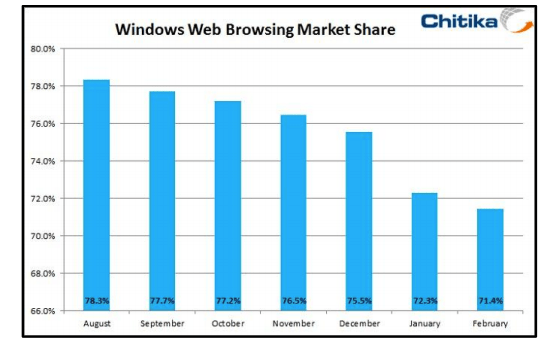Following up on its earlier report on iOS browser market share, ad network Chitika today released new results from a study which analyzed the impact mobile computing has had on traditional web browsing trends. In examining traffic across its network from August 2011 to February 2012, Chitika says that Windows web browsing market share has declined by almost 10%.
To determine its findings, Chitika analyzed data from hundreds of millions of ad impressions covering a cross section its network of 120,000 sites. Although a large sample size, we need to point out that this study is limited only to sites on the Chitika network. To be definitive, a larger study across multiple ad networks is still needed.
However, the data is interesting, especially in light of Chitika’s earlier discovery that iOS web traffic now surpasses that of Mac OS X. The firm theorizes that the new research, which involves an observed nearly* 10% decline in Windows web browsing market share, is due to the increase in browsing from mobile devices, including smartphones and tablets. That is to say, mobile browsing is eating into traditional PC-based browsing. But the drop may also be the result of decreased PC production in 2011 arising from the component shortages that occurred during the recent monsoon season. The monsoons led to flooding in Thailand, which disrupted factories, and therefore overall PC production.
On its own, data like this could be taken with the proverbial grain of salt, but other signs that we’re entered the “post-PC” era have already arrived. For example, earlier this month, analysts at Canalys reported two major shifts in computing trends: one, that smartphone shipments outpaced PCs for the first time ever, and two, that Apple has become the world’s largest PC maker, assuming iPads are counted as PCs.
With that data in hand, Chitika’s insights into its own network feels more like further confirmation of the ongoing trends, and less like some weird fluke occurring with a niche number of websites.
* The chart shows a drop from August 2011 (78.3%) to Feb. 2012 (71.4%), which would be a 6.9% drop. But the percentage change between the highest and lowest points referenced in the study come out to 9.66% which rounds up to 10%.
